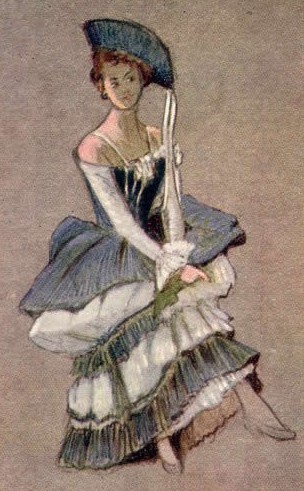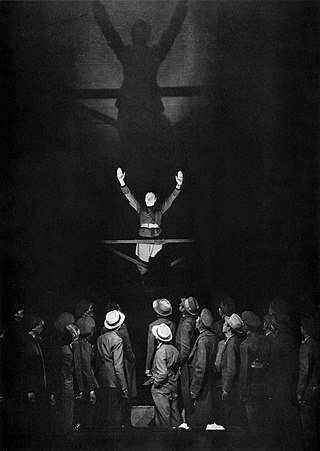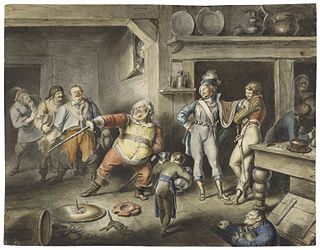Related Research Articles
In poetry, metre or meter is the basic rhythmic structure of a verse or lines in verse. Many traditional verse forms prescribe a specific verse metre, or a certain set of metres alternating in a particular order. The study and the actual use of metres and forms of versification are both known as prosody.

Mannerism is a style in European art that emerged in the later years of the Italian High Renaissance around 1520, spreading by about 1530 and lasting until about the end of the 16th century in Italy, when the Baroque style largely replaced it. Northern Mannerism continued into the early 17th century.

The Tragedy of Julius Caesar (First Folio title: The Tragedie of Ivlivs Cæsar), often abbreviated as Julius Caesar, is a history play and tragedy by William Shakespeare first performed in 1599.
In rhetoric, a rhetorical device, persuasive device, or stylistic device is a technique that an author or speaker uses to convey to the listener or reader a meaning with the goal of persuading them towards considering a topic from a perspective, using language designed to encourage or provoke an emotional display of a given perspective or action. They seek to make a position or argument more compelling than it would otherwise be.

Stage combat, fight craft or fight choreography is a specialised technique in theatre designed to create the illusion of physical combat without causing harm to the performers. It is employed in live stage plays as well as operatic and ballet productions. With the advent of cinema and television the term has widened to also include the choreography of filmed fighting sequences, as opposed to the earlier live performances on stage. It is closely related to the practice of stunts and is a common field of study for actors. Actors famous for their stage fighting skills frequently have backgrounds in dance, gymnastics or martial arts training.

In the First Folio, the plays of William Shakespeare were grouped into three categories: comedies, histories, and tragedies. The histories—along with those of contemporary Renaissance playwrights—help define the genre of history plays. The Shakespearean histories are biographies of English kings of the previous four centuries and include the standalones King John, Edward III and Henry VIII as well as a continuous sequence of eight plays. These last are considered to have been composed in two cycles. The so-called first tetralogy, apparently written in the early 1590s, covers the Wars of the Roses saga and includes Henry VI, Parts I, II & III and Richard III. The second tetralogy, finished in 1599 and including Richard II, Henry IV, Parts I & II and Henry V, is frequently called the Henriad after its protagonist Prince Hal, the future Henry V.

German expressionist cinema was a part of several related creative movements in Germany before the First World War that reached a peak in Berlin during the 1920s. These developments were part of a larger Expressionist movement in north and central European culture in fields such as architecture, dance, painting, sculpture and cinema.

Costume design is the creation of clothing for the overall appearance of a character or performer. Costume may refer to the style of dress particular to a nation, a class, or a period. In many cases, it may contribute to the fullness of the artistic, visual world which is unique to a particular theatrical or cinematic production. The most basic designs are produced to denote status, provide protection or modesty, or provide visual interest to a character. Costumes may be for a theater, cinema, musical performance, cosplay, parties, or other events. Costume design should not be confused with costume coordination which merely involves altering existing clothing, although both create stage clothes.
Iambic pentameter is a type of metric line used in traditional English poetry and verse drama. The term describes the rhythm, or meter, established by the words in that line; rhythm is measured in small groups of syllables called "feet". "Iambic" refers to the type of foot used, here the iamb, which in English indicates an unstressed syllable followed by a stressed syllable. "Pentameter" indicates a line of five "feet".

A tableau vivant, French for 'living picture', is a static scene containing one or more actors or models. They are stationary and silent, usually in costume, carefully posed, with props and/or scenery, and may be theatrically lit. It thus combines aspects of theatre and the visual arts.

Rome is a historical drama television series released 2005–2007 created by John Milius, William J. MacDonald, and Bruno Heller. The series is set in the 1st century BC, during Ancient Rome's transition from Republic to Empire. The series features a sprawling cast of characters, many based on real figures from historical records, but the lead protagonists are ultimately two soldiers named Lucius Vorenus and Titus Pullo, who find their lives intertwined with key historical events.

Julius Caesar is a 1953 American film adaptation of the Shakespearean play, directed by Joseph L. Mankiewicz and produced by John Houseman for Metro-Goldwyn-Mayer. It stars Marlon Brando as Mark Antony, James Mason as Brutus, John Gielgud as Cassius, Louis Calhern as Caesar, Edmond O'Brien as Casca, Greer Garson as Calpurnia, and Deborah Kerr as Portia.

This glossary of literary terms is a list of definitions of terms and concepts used in the discussion, classification, analysis, and criticism of all types of literature, such as poetry, novels, and picture books, as well as of grammar, syntax, and language techniques. For a more complete glossary of terms relating to poetry in particular, see Glossary of poetry terms.
In linguistics, ellipsis or an elliptical construction is the omission from a clause of one or more words that are nevertheless understood in the context of the remaining elements. There are numerous distinct types of ellipsis acknowledged in theoretical syntax. Theoretical accounts of ellipsis seek to explain its syntactic and semantic factors, the means by which the elided elements are recovered, and the status of the elided elements. Theoretical accounts of ellipsis can vary greatly depending in part upon whether a constituency-based or a dependency-based theory of syntactic structure is pursued.
A hyperforeignism is a type of qualitative hypercorrection that involves speakers misidentifying the distribution of a pattern found in loanwords and extending it to other environments, including words and phrases not borrowed from the language that the pattern derives from. The result of this process does not reflect the rules of either language. For example, habanero is sometimes pronounced as though it were spelled with an ⟨ñ⟩ (habañero), which is not the Spanish form from which the English word was borrowed.

"Friends, Romans, countrymen, lend me your ears" is the first line of a speech by Mark Antony in the play Julius Caesar, by William Shakespeare. Occurring in Act III, scene II, it is one of the most famous lines in all of Shakespeare's works.
Ellipsis is the narrative device of omitting a portion of the sequence of events, allowing the reader to fill in the narrative gaps. Aside from its literary use, the ellipsis has a counterpart in film production. It is there to suggest an action by simply showing what happens before and after what is observed. The vast majority of films use ellipses to clear actions that add nothing to the narrative. Beyond these "convenience" ellipses, ellipses are also used to advance the story.

Realism in the arts is generally the attempt to represent subject matter truthfully, without artificiality and avoiding speculative and supernatural elements. The term is often used interchangeably with naturalism, although these terms are not synonymous. Naturalism, as an idea relating to visual representation in Western art, seeks to depict objects with the least possible amount of distortion and is tied to the development of linear perspective and illusionism in Renaissance Europe. Realism, while predicated upon naturalistic representation and a departure from the idealization of earlier academic art, often refers to a specific art historical movement that originated in France in the aftermath of the French Revolution of 1848. With artists like Gustave Courbet capitalizing on the mundane, ugly or sordid, realism was motivated by the renewed interest in the common man and the rise of leftist politics. The realist painters rejected Romanticism, which had come to dominate French literature and art, with roots in the late 18th century.
American Sign Language literature is one of the most important shared cultural experiences in the American deaf community. Literary genres initially developed in residential Deaf institutes, such as American School for the Deaf in Hartford, Connecticut, which is where American Sign Language developed as a language in the early 19th century. There are many genres of ASL literature, such as narratives of personal experience, poetry, cinematographic stories, folktales, translated works, original fiction and stories with handshape constraints. Authors of ASL literature use their body as the text of their work, which is visually read and comprehended by their audience viewers. In the early development of ASL literary genres, the works were generally not analyzed as written texts are, but the increased dissemination of ASL literature on video has led to greater analysis of these genres.

History is one of the three main genres in Western theatre alongside tragedy and comedy, although it originated, in its modern form, thousands of years later than the other primary genres. For this reason, it is often treated as a subset of tragedy. A play in this genre is known as a history play and is based on a historical narrative, often set in the medieval or early modern past. History emerged as a distinct genre from tragedy in Renaissance England. The best known examples of the genre are the history plays written by William Shakespeare, whose plays still serve to define the genre. History plays also appear elsewhere in British and Western literature, such as Thomas Heywood's Edward IV, Schiller's Mary Stuart or the Dutch play Gijsbrecht van Aemstel.
References
- ↑ Harvey, Thomas Wadleigh (2008). A Practical Grammar of the English Language. BiblioBazaar, LLC. p. 263.
- ↑ Herzberg, Max John (1933). Off to Arcady: adventures in poetry . American book co. p. 35.
- ↑ Davis, Tracy C. (2005). "Do you believe in fairies? The hiss of dramatic license". Theatre Journal. 57 (1): 57–81. doi:10.1353/tj.2005.0007. S2CID 191351351.
- ↑ Goodsell, David S.; Johnson, Graham T. (2007). "Filling in the Gaps: Artistic License in Education and Outreach". PLoS Biol5 (12). doi : 10.1371/journal.pbio.0050308.
- ↑ Esaak, Shelley. "What is artistic license?". About.com. Archived from the original on August 12, 2009. Retrieved August 26, 2009.
- ↑ D'sa, Benicia (2005). "Social Studies in the Dark: Using Docudramas to Teach History". The Social Studies. 96 (1): 9–13. doi:10.3200/TSSS.96.1.9-13. S2CID 144165650.
- ↑ Toplin, Robert Brent (2002). Reel history: in defense of Hollywood. University Press of Kansas. p. 1.
- ↑ Barroll, J. Leeds (1975). Shakespeare Studies: An Annual Gathering of Research, Criticism, Reviews. Ayer Publishing. p. 306.
- ↑ Film review (1999). Issues 14–16. Orpheus Pub.